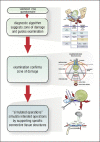Non-Hunner's Interstitial Cystitis Is Different from Hunner's Interstitial Cystitis and May Be Curable by Uterosacral Ligament Repair
- PMID: 35512665
- PMCID: PMC9393835
- DOI: 10.1159/000524321
Non-Hunner's Interstitial Cystitis Is Different from Hunner's Interstitial Cystitis and May Be Curable by Uterosacral Ligament Repair
Abstract
Background: The posterior fornix syndrome (PFS) was first described in 1993 as a predictably occurring group of symptoms: chronic pelvic pain (CPP), urge, frequency, nocturia, emptying difficulties/urinary retention, caused by uterosacral ligament (USL) laxity, and cured by repair thereof.
Summary: Our hypothesis was that non-Hunner's interstitial cystitis (IC) and PFS are substantially equivalent conditions. The primary objective was to determine if there was a causal relationship between IC and pelvic organ prolapse (POP). The secondary objective was to assess whether other pelvic symptoms were present in patients with POP-related IC and if so, which ones? How often did they occur? A retrospective study was performed in 198 women who presented with CPP, uterine/apical prolapse (varying degrees), and PFS symptoms, all of whom had been treated by posterior USL sling repair. We compared their PFS symptoms with known definitions of IC, CPP, and bladder symptoms. To check our hypothesis for truth or falsity, we used a validated questionnaire, "simulated operations" (mechanically supporting USLs with a vaginal speculum test to test for reduction of urge and pain), transperineal ultrasound and urodynamics.
Key messages: 198 patients had CPP and 313 had urinary symptoms which conformed to the definition for non-Hunner's IC. The cure rate after USL sling repair was CPP 74%, urge incontinence 80%, frequency 79.6%, abnormal emptying 53%, nocturia 79%, obstructive defecation 80%. Our findings seem to support our hypothesis that non-Hunner's IC and PFS may be similar conditions; also, non-Hunner IC/BPS may be a separate or lesser disease entity from "Hunner lesion disease". More rigorous scientific investigation, preferably by RCT, will be required.
Keywords: Chronic pelvic pain; Interstitial cystitis; Posterior fornix syndrome; Urinary urgency; Uterosacral ligaments.
© 2022 The Author(s). Published by S. Karger AG, Basel.
Conflict of interest statement
The authors have no conflicts of interest to declare.
Figures




References
-
- Abrams P, Cardozo L, Fall M, Griffiths G, Rosier P, Ulmsten U, et al. The standardization of terminology of lower urinary tract function: report from the standardisation sub-committee of the international continence society. Neurourol Urodyn. 2002;21:167–78. - PubMed
-
- Hanno PM, Erickson D, Moldwin R, Faraday MM. Diagnosis and treatment of interstitial cystitis/bladder pain syndrome: AUA guideline amendment. J Urol. 2015;193((5)):1545–53. - PubMed
-
- Meijink J. 2018 ESSIC meeting. Florence, Italy; Presidential Address. 2018. 29 Nov–1 Dec.
-
- Scheffler K, Hakenberg OW, Petros P, Petros PE. Cure of interstitial cystitis and non-ulcerating Hunner's ulcer by cardinal/uterosacral ligament repair. Urol Int. 2021;105((9–10)):920–3. - PubMed
-
- Petros PE, Ulmsten U. The posterior fornix syndrome: a multiple symptom complex of pelvic pain and abnormal urinary symptoms deriving from laxity in the posterior fornix. Scand J Urol Nephrol. 1993;27((Suppl 153)):89–93. - PubMed
Publication types
MeSH terms
LinkOut - more resources
Full Text Sources
Medical

